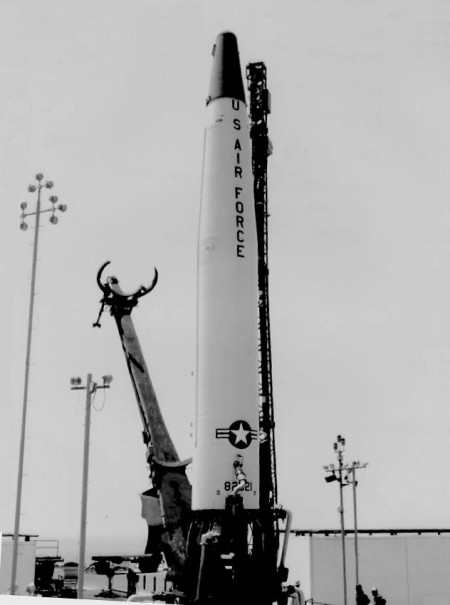Forty-one years ago this week, the last of the USAF/Boeing Thor Burner II launch vehicle series successfully orbited the SESP-1 space environment satellite. Launch took place from SLC-10W at Vandenberg Air Force Base, California on Tuesday, 08 June 1971.
The Thor Burner family of launch vehicles was designed to orbit classified meteorological satellites for the Defense Meteorological Satellite Program (DMSP). Launched into polar orbit, these satellites aided Keyhole spy satellite operations by ensuring that target imaging took place only over sparsely-clouded terrain.
The liquid-fueled Thor SM-75 missile served as the first stage of the Thor Burner launch vehicle. The Thor airframes selected for the program formerly stood sentinel in Europe in the Intermediate Range Ballistic Missile (IRBM) role. The Burner upper stages utilized solid propellant propulsion.
There were four (4) versions of Thor Burner as distinguished principally by the type of solid propellant rocket motor employed in the upper stage(s) and the orbitable payload mass. Thor Burner 1 used a single Altair-type solid motor upper stage which produced about 5,000 lbs of thrust for 27 seconds. The upper stage and satellite payload were spin stabilized. A total of six (6) Thor Burner I vehicles were flown.
Thor Burner II employed a single Star 37B solid motor which generated 10,000 lbs of thrust for 42 seconds. The upper stage had its own 3-axis flight control system that incorporated multiple hot and cold gas reaction jets. The solid rocket motor and satellite payload were contained within a hemispherically-blunted conical fairing that was colored a distinct orange-red. Thor Burner II flew twelve (12) times.
Thor Burner IIa was a three-stage configuration. A Star 37D (slightly less energetic than the Star 37B) solid motor powered the third stage which was accomodated through the addition of a cylindrical section inserted between the Thor first stage and the hemispherically-blunted conical fairing. Eight (8) Thor Burner IIa vehicles were launched.
The fourth and final Thor Burner variant was essentially a modified Thor Burner IIa vehicle. The second and third stages were now powered by a Star 37XE and Star 37S-IISS rocket motor, respectively. The shape of the external fairing was the same as that of the Thor Burner IIa, only a higher degree of nose blunting was used. A total of five (5) of these vehicles were flown.
The Thor Burner series flew from 1965 through 1980. Twenty-eight (28) of the thirty-one (31) missions were rated as successful. Indeed, the Burner concept proved so effective that variants thereof showed-up on the Atlas and Titan missile programs. Little-remembered today, the Thor Burner Program holds an important place in the annals of American aerospace history.

